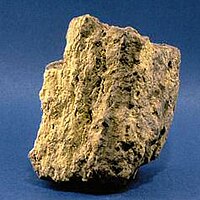
Photo from wikipedia
Abstract The features and similarities in the geology of paleovalley-related uranium mineralizing systems in Australia and China can be used to refine strategies for exploration. Paleovalley-related uranium resources include sandstone-,… Click to show full abstract
Abstract The features and similarities in the geology of paleovalley-related uranium mineralizing systems in Australia and China can be used to refine strategies for exploration. Paleovalley-related uranium resources include sandstone-, lignite- and calcrete-style deposits that are developed within the host sediments deposited in paleovalleys. The paleovalleys incise either crystalline bedrock or older sedimentary rocks, and uranium was deposited and concentrated by the influx of oxidized/reduced groundwaters flowing in aquifers within the paleovalley fill. The critical features of paleovalley-related uranium deposits include sediment and uranium sources, geological setting, depositional environment, age and relative timing of mineralization, aquifer characteristics, availability and distribution of reductants, and preservation potential of the uranium mineral system. This set of information provides a basis to establish the uranium mineralization model, which can then be used to assist with generating targets for uranium exploration and prospectivity analysis of a region. With respect to Sino-Australian examples, paleovalley-related uranium deposits form mostly around the margins of sedimentary basins and the mineralization is commonly hosted within channel fills contained within paleovalleys developed upon, or proximal to, Precambrian crystalline rocks that contain primary uranium sources. The deposits that have been well studied show remarkably similar factors that controlled the formation of paleovalley-related uranium deposits. Basement/bedrocks with above-background (2.8 ppm U) levels of uranium (10–100 ppm) that are linked to, and/or, incised by paleovalleys are associated with these deposits and are the inferred source of the uranium. In these regions, extensive fluvial systems developed particularly during Mesozoic and Cenozoic times, uranium from the bedrock was first dispersed into the sediments, and then concentrated to form deposits through successive chemical remobilization, precipitation and concentration. The deposits formed in continental or marginal marine environments, and commonly are associated with reduced lithologies, containing pyrite and dispersed organic matter and/or seams of lignite, or show evidence of infiltrated hydrocarbons. The mineralization is developed where oxidizing fluids (carrying dissolved U) reacted with reductants in the sediments. Geological, geophysical and geochemical features of the paleovalleys and related uranium deposits are used to construct models to understand host sediment distribution, fluid flow and ore genesis that can assist exploration for paleovalley-hosted uranium deposits. Precise geometric definition of the basin margin and paleovalley architecture is important in identifying exploration targets and improving the effectiveness of drilling. Refinements in remote sensing, geophysical and data processing techniques, in combination with sedimentological and depositional interpretations, provide an efficient approach for outlining the principal drainage patterns and channel dimensions. To help reduce risk, an exploration strategy should combine these technologies with a detailed understanding of the physicochemical parameters controlling uranium mobilization, precipitation and preservation.
Journal Title: Ore Geology Reviews
Year Published: 2017
Link to full text (if available)
Share on Social Media: Sign Up to like & get
recommendations!